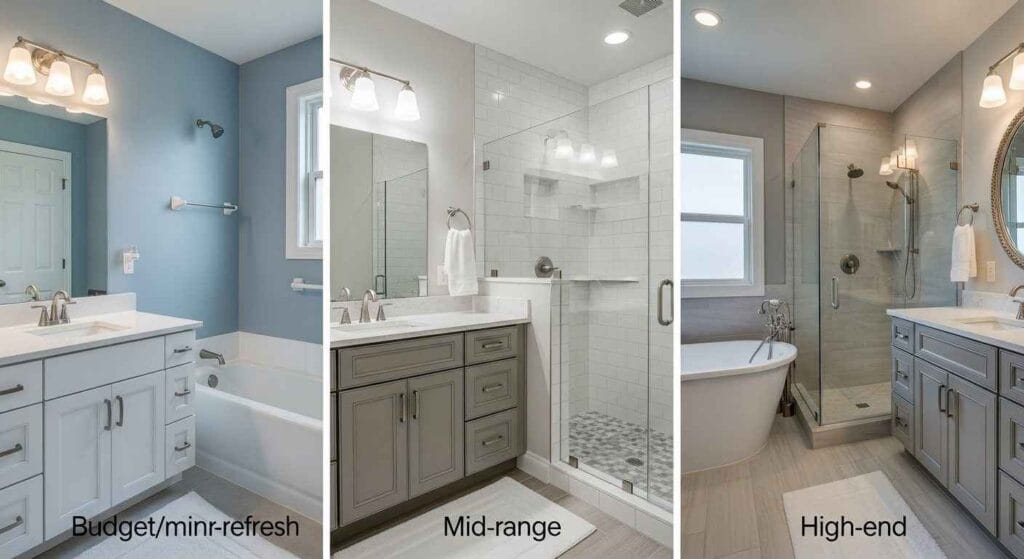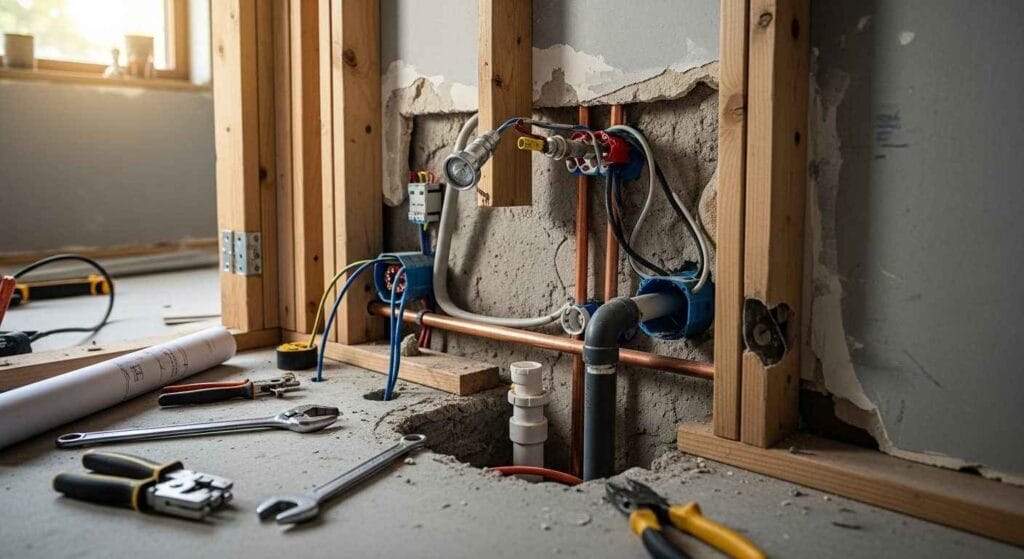When you’re thinking about renovating your bathroom, the first question on everyone’s mind is always, “What’s this going to cost me?” It’s a fair question, and frankly, it’s one of the most critical aspects of any successful project. Understanding the true financial scope of a bath remodeling project before you even pick out a tile is what separates a smooth renovation from a stressful ordeal.
Most homeowners get stuck trying to guess figures or rely on general averages. My goal here is to give you a clear, honest look at what really drives bath remodeling costs and how you can get a solid estimate, drawing from decades of on-the-ground experience. This bath remodeling cost estimator will provide the insights you need for your 2025 project.
How to Effectively Use a Bath Remodel Cost Calculator
Online bath remodel cost estimators or calculators can be a great starting point, but you need to know their limitations. Think of them as a compass, not a GPS. They give you a general direction, a broad range, usually based on national averages and basic inputs like square footage and the quality of finishes, such as budget, mid-range, or high-end options. These tools are excellent for getting a rough idea of what a bathroom remodel might cost in your area.
To get the most out of them, be as specific as you can. Don’t just pick “mid-range.” Consider if you’re replacing fixtures like the toilet and vanity, or if you’re gutting everything down to the studs. Are you moving plumbing lines? That’s a huge cost driver that many calculators might not fully account for without detailed questions.
My advice is to use several different calculators and average their results. This gives you a more balanced baseline to work from. It’s always wise to assume the actual project will land somewhere in the higher end of that range, especially if you anticipate any surprises that could increase your bathroom renovation costs.
Average Bathroom Remodel Costs in 2025: What to Expect

Let’s talk real numbers, keeping in mind that these are averages and can swing wildly based on your location and the specifics of your home. As of 2025, a minor bathroom refresh, often involving just painting, updating the vanity, light fixtures, and possibly replacing a toilet, might run you anywhere from $5,000 to $10,000. This is your “cosmetic update” range, where you are not moving walls or major plumbing.
For a mid-range bathroom renovation, where you’re replacing most fixtures, potentially re-tiling the floor and shower surround, and maybe even reconfiguring the layout slightly without moving major plumbing lines, you’re typically looking at $15,000 to $30,000. This is where most homeowners land, opting for good quality, durable materials like ceramic or porcelain tiles, solid wood vanities, and reliable brand-name fixtures like Kohler or Delta.
On a recent project, a client wanted to convert their old tub-shower combo into a walk-in shower. We kept the existing footprint, which saved significantly on plumbing costs, but opted for higher-end porcelain tiles and a frameless glass enclosure, pushing their total close to the $25,000 mark. This reflects typical bathroom remodel prices for a quality mid-range upgrade.
Then you have your high-end or master bathroom remodels, which often involve moving walls, relocating plumbing and electrical, custom cabinetry, heated floors, steam showers, and premium natural stone like marble or quartz. These projects can easily start at $35,000 and climb well over $75,000, sometimes even reaching six figures for truly luxurious, custom spaces. I’ve seen some master bathrooms turn into spa-like retreats, but those always come with a hefty price tag due to specialized labor and top-tier materials.
Key Factors Influencing Your Bath Remodeling Costs
So, what truly moves the needle on your bath remodeling cost estimator? It boils down to a few critical areas:
Scope of Work and Layout Changes

This is arguably the biggest cost influencer for any bathroom renovation. Are you simply replacing old with new in the same spot, or are you gutting the space and changing the entire layout? Moving plumbing lines for a toilet, shower, or sink is incredibly labor-intensive and requires skilled tradespeople. Rewiring for new lighting or moving outlets also adds significant cost.
Each time you deviate from the existing footprint, imagine dollar signs adding up. On older homes, opening walls often reveals unexpected issues like outdated wiring or corroded pipes that need immediate attention, adding unforeseen costs to your bathroom remodel prices.
Material Selections
The choices you make here have a colossal impact on your overall bathroom renovation budget.
Tiles: Ceramic and basic porcelain are cost-effective. High-end porcelain, natural stone like marble or granite, and intricate mosaic patterns will drastically increase costs, not just for the material itself but for the specialized labor required for installation. A large format tile might save on grout lines but can be trickier to install perfectly.
Fixtures: A basic acrylic tub might cost a few hundred dollars, while a cast iron clawfoot tub or a jetted soaking tub could be thousands. Similarly, a standard chrome faucet from Moen or Delta is far less expensive than a designer bronze fixture from brands like Kallista or Watermark Designs. Toilets range from basic models around $150 to high-efficiency, wall-mounted, or smart toilets that can cost over $1,000.
Vanity and Countertops: Pre-fabricated vanities with integrated sinks are budget-friendly. Custom cabinetry with quartz, granite, or solid surface countertops will drive up costs significantly.
Shower Enclosures: A basic curtain rod is cheapest. Framed glass doors are moderate. A custom frameless glass enclosure for a walk-in shower is the most expensive option, often requiring precise measurements and specialized installation, heavily impacting bathtub renovation costs if you’re converting.
Labor Costs
This is where local market rates come into play. Skilled tradespeople—plumbers, electricians, tile setters, and carpenters—command fair wages. Labor can often account for 40-60% of your total project cost. In densely populated urban areas, expect higher labor rates than in more rural settings.
Don’t skimp here; quality craftsmanship prevents costly problems down the road. I’ve seen homeowners try to cut corners on plumbing, only to end up with leaks and ruined drywall months later. This is a crucial component of accurate bath remodeling costs.
Permits and Inspections
Never skip these. Building permits ensure your project meets local safety codes and regulations. While they add a few hundred dollars to your bath remodeling cost estimator, avoiding them can lead to hefty fines, stop-work orders, or even requiring you to tear out completed work. They’re a necessary part of doing things right and ensuring the safety and legality of your bathroom remodel.
DIY vs. Professional Bathroom Remodel: A Cost Comparison

Many homeowners consider a DIY approach to save money, and it can be cheaper, but it’s not for everyone. If you have solid experience in carpentry, plumbing, electrical, and tiling, then tackling some aspects yourself makes sense. You save on labor, which as I mentioned, is a huge chunk of the budget. For example, demolition is often something an eager homeowner can handle safely, saving some initial bathroom renovation costs.
However, a mistake I often see is homeowners underestimating the complexity and time involved. What takes a professional a day might take a novice a week, and any errors—a crooked tile, a leaky pipe, an incorrectly wired outlet—will cost more to fix than if you’d hired a pro in the first place. You also need to factor in tool rental costs and the sheer exhaustion of doing it yourself after a full day’s work.
Hiring a professional contractor means you’re paying for expertise, efficiency, insurance, and peace of mind. A good contractor manages the entire project, coordinates trades, handles permits, and stands behind their work. While the upfront cost is higher, the value in terms of a quality finish, proper installation, and adherence to codes is often worth every penny.
For anything involving significant plumbing or electrical work, or complex tile patterns, I always recommend bringing in the pros. Trying to save a few hundred dollars on critical infrastructure can lead to thousands in repair costs later.
Smart Strategies to Save Money on Your Bath Renovation

Saving money doesn’t always mean sacrificing quality. It means making smart, informed decisions that align with your bathroom renovation budget.
Prioritize Your Must-Haves: Before you start, list what’s most important to you. Is it a high-end shower experience or stunning natural stone? Decide where you’re willing to splurge and where you can compromise. My experience tells me that homeowners who go in with a clear hierarchy of needs are happier with their budget and their outcome.
Keep the Layout: This is the golden rule for cost-saving. If you can keep your toilet, sink, and shower/tub in their existing locations, you’ll save a significant amount on plumbing labor and materials. Even shifting a toilet by a few inches can incur additional costs, substantially affecting your bath remodeling costs.
Smart Material Selection: Your choices here can significantly impact your overall bath remodeling costs.
Tiles: Opt for high-quality porcelain or ceramic instead of natural stone. They’re durable, beautiful, and much less expensive. Large format tiles can also save on installation time and grout, which indirectly saves money.
Fixtures: Choose well-regarded mid-range brands like Moen, Delta, or American Standard. They offer excellent quality and warranties without the designer price tag.
Vanity: Consider pre-fabricated vanities. Many come with beautiful, durable countertops like cultured marble or quartz already integrated, saving you the cost of custom fabrication.
Tub Refinishing vs. Replacement: For older, cast iron tubs in good structural condition, refinishing (re-glazing) can be a cost-effective alternative to full replacement. It can cost anywhere from $400 to $800, while a new tub installation can easily be $1,500 to $5,000 or more, depending on the tub type and installation complexity. If the tub is acrylic, stained, or chipped, refinishing might not be as durable, so assess its condition honestly.
Strategic DIY: Handle demolition yourself if you’re capable and careful. Painting is another task many homeowners can tackle. Just be realistic about your skill level and time commitment for each task in your bathroom remodel.
Buy Materials During Sales: Keep an eye out for sales at local tile stores, home improvement centers, and plumbing supply houses. Planning your renovation around these sales can result in substantial savings on materials, optimizing your bathroom renovation budget.
Get Multiple Bids: Always get at least three detailed quotes from licensed and insured contractors. This allows you to compare costs, scope of work, and ensure you’re getting a fair price for your bath remodeling project. Don’t just go for the cheapest bid; evaluate the contractor’s experience, references, and communication style.
A successful bathroom remodel isn’t just about the aesthetics; it’s about smart planning and financial wisdom. Understanding what truly influences your bath remodeling cost estimator empowers you to make informed choices, avoid nasty surprises, and ultimately create a space you’ll love without breaking the bank. Ready to transform your bathroom? Start by getting an accurate estimate today!
How long does a typical bathroom remodel take?
From my experience, a small to mid-sized bathroom remodel typically takes 3 to 4 weeks from demolition to final touches, assuming no major structural changes or unexpected issues. Larger, more complex projects can easily extend to 6-8 weeks or even longer.
What bathroom upgrades offer the best return on investment?
Minor upgrades like a fresh coat of paint, new light fixtures, a modern vanity, and updating the toilet generally offer the best return.
For larger projects, focusing on high-quality, neutral finishes and improving functionality, like adding a second sink or a walk-in shower, tends to yield better ROI than highly personalized or trendy selections.
These choices can also positively impact your overall bath remodeling costs by adding long-term value.
What are some common hidden costs I should prepare for?
Always budget an additional 10-15% for contingencies. Common hidden costs include unexpected plumbing or electrical repairs once walls are opened, dry rot or mold remediation, unforeseen subfloor damage, and the need to upgrade ventilation systems to meet current codes. Permitting fees are another cost often overlooked in initial estimates for a bathroom remodel.




